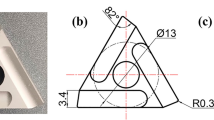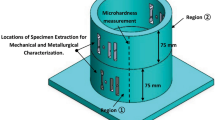Abstract
The Inconel 718 superalloy is widely used in petrochemical, energy, aerospace, nuclear power plants, and many other applications where components are subjected to high temperatures and corrosion environments. This alloy is most used due to its combination of good mechanical properties and relatively low cost compared to other supperalloys. Nevertheless, its mechanical properties and workpieces with very complex geometries are difficult to be manufactured by conventional machining properties. It is observed that notch wear at the cutting tool tip and superabrasive carbides in Inconel 718 promote high abrasive cutting tool wear; high diffusion wear happens at cutting tool, continuous and tough chips cause degradation of the cutting tool, and both high temperature and thermal gradients occur at the cutting tools due to low thermal diffusivity of these alloys. Wire electrical discharge machining is a precision non-traditional machining process that appears as an alternative to the conventional machining process for any hard and electrically conductive material. The objective of this research work is to compare the technological performance of WED-Machining Inconel 718 using a reciprocating molybdenum wire electrode using two types of dielectric fluids (deionized water and 8% emulsion hydrocarbon) under different electrical parameters. Therefore, it presents the investigation of the discharge energy influences for five different levels of discharge durations and varying the wire run-off speed. Technological aspects labeled material cutting rate, kerf width, wire feed rate, and surface integrity were evaluated. The results revealed that the hydrocarbon presented a higher cutting rate than deionized water independent of the discharge energy applied. The hydrocarbon dielectric presented the best results for the wire feed rate compared to water fluid. The largest kerf width was attained for the deionized water, and the surface roughness increase is more pronounced for deionized water than hydrocarbon dielectric.













Similar content being viewed by others
Abbreviations
- d w :
-
Wire diameter (mm)
- \({\overline{i}}_{e}\) :
-
Discharge current (A)
- \({\overline{u}}_{e}\) :
-
Discharge voltage (V)
- t e :
-
Discharge duration (µs)
- t i :
-
Pulse duration (µs)
- t o :
-
Pulse interval time (µs)
- t p :
-
Pulse cycle time (µs)
- f p :
-
Pulse frequency (fp = ti/tp)
- Ra:
-
Average roughness-two-dimensional (µm)
- Sa:
-
Average height of the selected area-three-dimensional (µm)
- P in :
-
Dielectric inlet pressure (MPa)
- W e :
-
Discharge energy (J)
- W s :
-
Wire run-off speed (m/s)
- Λc :
-
Cut-off sampling length (µm
References
Parida AK, Maity K (2018) Comparison the machinability of Inconel 718, Inconel 625 and Monel 400 in hot turning operation. Eng Sci Technol Int J 21:364–370. https://doi.org/10.1016/j.jestch.2018.03.018
Zink ES, Bourdon D, Neias Junior V et al (2020) Study of manufacturing processes for liquid rocket turbopump impellers: Test and analysis. J Aerosp Technol Manag 12:1–14. https://doi.org/10.5028/jatm.v12.1099
Sharma V, Misra JP Singhal P (2019) Multi-optimization of process parameters for Inconel 718 while Die-Sink EDM using multi-criterion decision making methods. J Phys Conf Ser 1240. https://doi.org/10.1088/1742-6596/1240/1/012166
Gustafsson D, Moverare JJ, Johansson S et al (2011) Influence of high temperature hold times on the fatigue crack propagation in Inconel 718. Int J Fatigue 33:1461–1469. https://doi.org/10.1016/j.ijfatigue.2011.05.011
Ezugwu EO (2005) Key improvements in the machining of difficult-to-cut aerospace superalloys. Int J Mach Tools Manuf 45:1353–1367. https://doi.org/10.1016/j.ijmachtools.2005.02.003
Johny A, Thiagarajan C (2020) Investigation of surface integrity and it’s optimization on pure titanium using molybdenum wire by reciprocated travelling WEDM — a review. Mater Today Proc 33:2581–2584. https://doi.org/10.1016/j.matpr.2019.12.251
Li L, Li ZY, Wei XT, Cheng X (2015) Machining characteristics of inconel 718 by sinking-EDM and wire-EDM. Mater Manuf Process 30:968–973. https://doi.org/10.1080/10426914.2014.973579
Ho KH, Newman ST, Rahimifard S, Allen RD (2004) State of the art in wire electrical discharge machining (WEDM). Int J Mach Tools Manuf 44:1247–1259. https://doi.org/10.1016/j.ijmachtools.2004.04.017
Mendes LA, Amorim FL, Weingaertner WL (2014) Automated system for the measurement of spark current and electric voltage in wire EDM performance. J Brazilian Soc Mech Sci Eng 37:123–131. https://doi.org/10.1007/s40430-014-0171-x
Klocke F, König W (2007) Fertigungsverfahren 3. Abtragen, Generieren und Lasermaterialbearbeitung. Springer Berlin Heidelberg, Berlin
Reolon LW, Laurindo CAH, Torres RD, Amorim FL (2019) WEDM performance and surface integrity of Inconel alloy IN718 with coated and uncoated wires. Int J Adv Manuf Technol 100:1981–1991. https://doi.org/10.1007/s00170-018-2828-6
Dabade UA, Karidkar SS (2016) Analysis of response variables in WEDM of Inconel 718 using Taguchi technique. Procedia CIRP 41:886–891. https://doi.org/10.1016/j.procir.2016.01.026
Werner A (2016) Method for enhanced accuracy in machining curvilinear profiles on wire-cut electrical discharge machines. Precis Eng 44:75–80. https://doi.org/10.1016/j.precisioneng.2015.10.004
Carlini GC, Xavier FA, Weingaertner WL et al (2018) Análise de parâmetros na remoção de metal duro utilizando WEDM. An do X Congr Nac Eng Mecânica. https://doi.org/10.26678/ABCM.CONEM2018.CON18-1266
Niamat M, Sarfraz S, Aziz H et al (2017) Effect of different dielectrics on material removal rate, electrode wear rate and microstructures in EDM. Procedia CIRP 60:2–7. https://doi.org/10.1016/j.procir.2017.02.023
Kunieda M, Kitamura T (2018) Observation of difference of EDM gap phenomena in water and oil using transparent electrode. Procedia CIRP 68:342–346. https://doi.org/10.1016/j.procir.2017.12.065
Carlini GC, Amorim FL, Weingaertner WL (2019) Influence of different grades of CuW electrodes when die sinking ED-machining of cemented carbide. Int J Adv Manuf Technol. https://doi.org/10.1007/s00170-019-03982-x
Klocke F (2009) Manufacturing processes 2, RWTH. Springer Berlin Heidelberg, Berlin, Heidelberg
ASTM (2018) ASTM B387-18. Standard specificstandard specification for molybdenum and molybdenum alloy bar, rod, and wire, ASTM International, West Conshohocken, PA, 2018
Baldin V, Baldin CRB, Machado AR, Amorim FL (2020) Machining of Inconel 718 with a defined geometry tool or by electrical discharge machining. J Brazilian Soc Mech Sci Eng 42:1–14. https://doi.org/10.1007/s40430-020-02358-7
Yue X, Yang X, Kunieda M (2018) Influence of metal vapor jets from tool electrode on material removal of workpiece in EDM. Precis Eng 53:278–288. https://doi.org/10.1016/j.precisioneng.2018.04.012
Puri AB (2017) Advancements in micro wire-cut electrical discharge machining 145–178. https://doi.org/10.1007/978-3-319-52009-4_4
ISO (1997) ISO 4287. Geometrical product specifications (GPS) — surface texture: profile method — terms, definitions and surface texture parameters
ISO (2012) ISO 25178-2. Geometrical product specifications (GPS). Surface texture: Areal — part 2: terms, definitions and surface texture parameters
ISO (1996) ISO 4288. Geometrical product specifications (GPS) - surface texture: profile method — rules and procedures for the assessment of surface texture
Deltombe R, Kubiak KJ, Bigerelle M (2014) How to select the most relevant 3D roughness parameters of a surface. Scanning 36:150–160. https://doi.org/10.1002/sca.21113
VDI (1990) VDI 3402. Elektroerosive bearbeitung: definitionen und terminologie. Deutsches Institut für Normung. Düsseldorf
Author information
Authors and Affiliations
Corresponding author
Ethics declarations
Ethics approval
Not applicable.
Consent to participate
Not applicable.
Consent for publication
Not applicable.
Conflict of interest
Not applicable.
Additional information
Publisher's note
Springer Nature remains neutral with regard to jurisdictional claims in published maps and institutional affiliations.
Rights and permissions
About this article
Cite this article
Carlini, G.C., da Silva, C., Torres, R.D. et al. WED-machining performance by reciprocating molybdenum wire on Inconel 718 with water or hydrocarbon dielectrics. Int J Adv Manuf Technol 119, 1853–1866 (2022). https://doi.org/10.1007/s00170-021-08386-4
Received:
Accepted:
Published:
Issue Date:
DOI: https://doi.org/10.1007/s00170-021-08386-4




